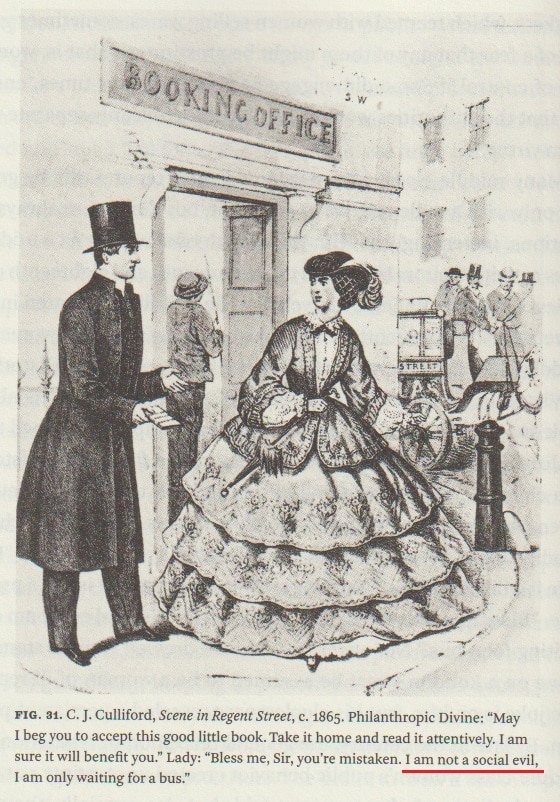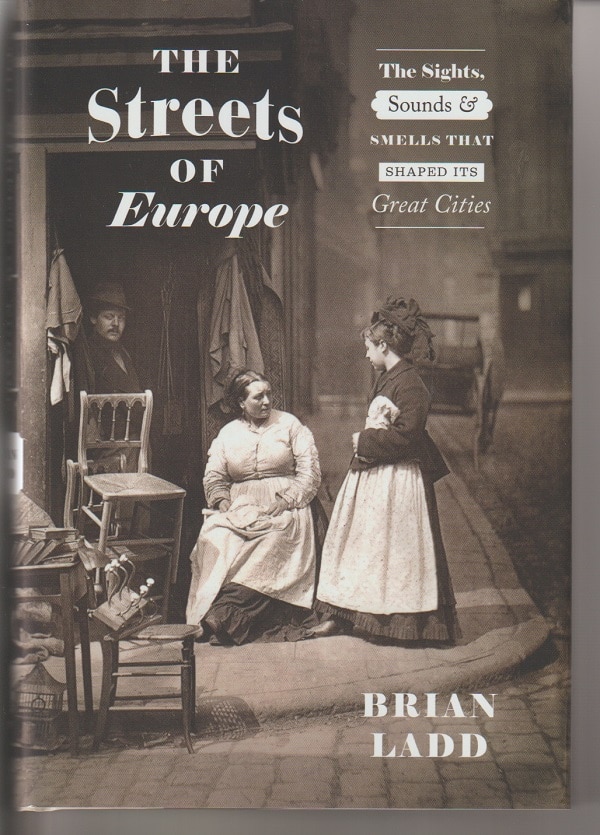I’m having a difficult time deciding what, dear reader, to tell you first.
Let’s put it this way: The streets of Paris, London, Vienna and Berlin in the 1700s and 1800s were very different from the streets you move along here in Chicago. And they were also very much the same.
That’s what I come away with from Brian Ladd’s The Streets of Europe: The Sights, Sounds and Smells That Shaped Its Great Cities. Make no mistake: This is an academic book from one of the most prestigious academic presses in the U.S., the University of Chicago Press, and is very scholarly. But, in this case, at least, scholarly doesn’t mean dull.
Ladd writes that he seeks to “evoke the social frictions and stinking horrors that repelled contemporaries along with the delight they took in the sights and sounds, and even the smells, of their streets.” And his book is a buoyant account of street life in those European cities (which, for those of you who are history buffs, wasn’t all that different from the sights, sounds and smells of life in Chicago during those pre-1900 years, as Adam Mack detailed in his 2015 book Sensing Chicago: Noisemakers, Strikebreakers, and Muckrakers, from the University of Illinois Press).
If I were to take you back a century and a half to one of those four cities, you’d find much about the streets to be foreign to your 21st-century Chicago sensibilities. And yet…well, I’ll get to that at the end.
“Run down by a coach”
But, first, I need to solve the conundrum of what to tell you first about the differences. I think I’ll start with the way the rich and the poor shared the pavement — or, as in this case, didn’t.
In Europe, the gaps between the classes were chasms. The rich, particularly the aristocracy, had a sense of moral superiority, bolstered by law, that meant they could get away with a lot when it came to everyone else. One visiting Scottish physician wrote in 1779 that pedestrians in Paris had to “grope their way as best they can, and skulk behind pillars, and run into shops, to avoid being crushed by the coaches [of the wealthy], which are driven as near the wall as the coachman pleases; dispersing the people on foot at their approach, like chaff before the wind.” Ladd writes:
“The infamous heedlessness of Parisian aristocrats and their drivers in the narrow, crowded, sidewalk-less streets often had deadly results, as we know from many reports of horrified bystanders such as Sir James Edward Smith in 1787, who was appalled to see someone run down by a coach and then be told that there would be no consequences, ‘because it is a nobleman’s carriage.’ ”
A lot of crap
There were horses drawing those carriages, and there were horses drawing wagons, and myriad other animals on the street, including pigs, chickens, dogs, cats and cattle. In fact, 1.8 million cattle, an average of 5,000 a day, were herded through London in 1848 to the central livestock market.
The result was, literally, a lot of crap.
Well, a lot of dung and urine in the street as well as a lot of other stuff, such as sawdust and ashes, and blood and grease from butchers and other trades, and food scraps from houses, tossed out upper floor windows, and, well, there’s no delicate way to say this, human urine and excrement, dumped in the street from chamber pots and cesspits or voided directly from indisposed people walking, working in or living in the streets.
Ladd explains that “an impressive portion of this waste was scavenged” by pigs and dogs. (In the earlier book about Chicago, Mack notes that the keeping of pigs not only kept the streets cleaner but also fattened up the pigs for sale or the home dinner table.) As for whatever was left, Ladd writes:
“The rest found its way into open gutters located in the center of the street or along each side. In dry weather the filth turned to dust and blew about in choking clouds. Wet weather might be even more unpleasant, with pedestrians stranded in ankle-deep muck.”
“Not a social evil”
Such filth, muck, mud, dust — whatever you call it wreaked havoc with the long, voluminous skirts of middle-class and upper-class women whenever they had to walk. But a direct and much more personal nuisance had to do with how such women, if they were alone on the street, were perceived by men.
The thing was that prostitutes, in order to attract clients, had to be on the street, but they faced immediate arrest if they were too blatant about the services they were offering. So, they dressed as closely as possible to a middle-class woman.
As a consequence, the whore might be mistaken by a passing man for a middle-class woman, and a middle-class woman for a whore. Ladd notes:
“The typical scene of misunderstandings was an elegant shopping street such as Regent Street, the rue Saint-Honore, or the Graben. A woman who lingered outside the fashionable shops might indeed be a prostitute exploiting the commercial atmosphere. Or she might be a working-class girl gazing hungrily at the unaffordable goods on display. Or she might be a middle-class daughter or wife with both the desire and the means to buy lace or a hat or a set of teacups.”
A respectable woman alone on the street risked the approach of a man with a scandalous proposition, or, perhaps worse, the approach of a minister intent on saving the soul of a streetwalker. Ladd provides a copy of a lithograph of such a reverend’s approach, and the caption has the woman responding,
“Bless me, Sir, you’re mistaken. I’m not a social evil.”

“Women covered with dust”
Women in their turn, however, could be just as judgmental when it came to other inconveniences, for instance, the many people who worked in and along the street.
In addition to the vendors and deliverymen, various trades found the streets useful, such as artisans whose “work spilled out the front doors of their workshops to take advantage of sunlight, space, and sociability.” There were outdoor restaurant tables and street entertainers and street preachers and “muscular laundresses [who] lined the banks of some inner-city streams and canals.”

All these workers got in the way of their “betters,” i.e., the middle and upper classes, who were on their way somewhere or just out for a stroll. In 1835, Frances Trollope, the British novelist and mother of the even more famous novelist Anthony Trollope, complained about the street-laborers on the fashionable boulevard des Italiens in Paris. She huffed that it was impossible to avoid
“being frequently obliged to turn aside, that you may not run against two or more women covered with dust, and probably with vermin, who are busily employed in pulling their flock mattresses to pieces in the street. There they stand or sit, caring for nobody, but combing, turning, and shaking the wool upon all comers and goers; and, finally, occupying the space round which many thousand passengers are obliged to make what is always an inconvenient, and sometimes very dirty detour.”
“Avoid streets almost entirely”
As these few examples show, the streets of London, Paris, Berlin and Vienna before 1900 were dangerous, mucky, smelly, crowded with workers and a threat to the reputations of unaccompanied women. These are just a few of the ways that the streetscape then is different from that of Chicago today.
Much of the past century and more has been spent by First-World governments and planners to clear streets so that traffic can zoom along at speed and to provide more order to things. At the same time, there has been a distinct cultural movement toward greater privacy, abetted by technical advances that, for instance, provide in-home entertainment and air conditioning. Endless suburban subdivisions are a testament to both tendencies.
“Many North Americans and Europeans,” writes Ladd, “manage to avoid streets almost entirely, except while encased in a car.”
Nonetheless, those who live in Chicago and any other city know the elation of a crowded street or, at least, crowded sidewalks. There is a joy at being alone and part of a crowd at the same time.
“Fullness of joy at so much life”
In this time of Covid, such crowds, of course, are to be avoided — alas. Yet, once the all-clear is given, we’ll again be able to find delight in plunging into the river of people strolling along city sidewalks, window-shopping bright stores and clustering together to enter Wrigley Field or cheer a marathon or pose for a tour group photo.
Ladd’s book makes it clear that this enjoyment was similarly felt back before 1900 in those major four European cities. German scholar Wilhelm von Humboldt, for example, wrote in 1789 that the “monstrous swarm” of Paris gave him “a pleasant feeling.”
“In the ceaseless whirl, in the indescribably mass of humanity, the individual vanishes so completely that no one pays heed to anyone else, no one shows any consideration to anyone; indeed, one is pulled along in the current so forcefully that one feels like a mere drop in the ocean. I like it.”
The Romantic poet William Wordsworth called himself a “worshipper of nature,” but his close friend, English writer Charles Lamb, was enamored of cities, acknowledging in a letter his passion for “streets, streets, streets.” In that letter, Lamb wrote:
“The lighted shops of the Strand and Fleet Street; the innumerable trades, tradesmen and customers, coaches, wagons, playhouses; all the bustle and wickedness round about Covent Garden; the very women of the town; the watchmen, drunken scenes, rattles; life awake, if you awake, at all hours of the night; the impossibility of being dull in Fleet Street; the crowds, the very dirt and mud, the sun shining upon houses and pavements, the print shops, the old bookstalls, parsons cheapening books, coffee houses, steams of soups from kitchens, the pantomimes — London itself a pantomime and a masquerade — all these things work themselves into my mind, and feed me, without a power of satiating me.
“The wonder of these sights impels me into night walks about her crowded streets, and I often shed tears in the motley Strand from fullness of joy at so much life.”
Yes, there are still people, like Wordsworth, who, with their “rural emotions,” have no need for cities and city streets.
Yet, there are also people, dear reader, and you can count me among them, who exult at the “fullness of joy at so much life” on a crowded city street.
Patrick T. Reardon
10.16.20
Written by : Patrick T. Reardon
For more than three decades Patrick T. Reardon was an urban affairs writer, a feature writer, a columnist, and an editor for the Chicago Tribune. In 2000 he was one of a team of 50 staff members who won a Pulitzer Prize for explanatory reporting. Now a freelance writer and poet, he has contributed chapters to several books and is the author of Faith Stripped to Its Essence. His website is https://patricktreardon.com/.
